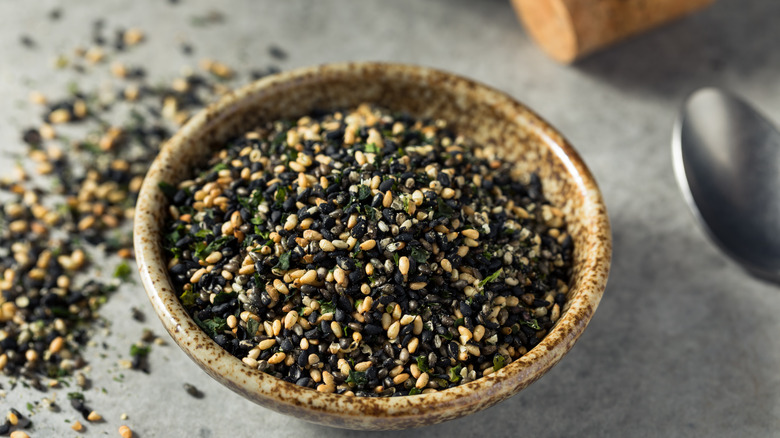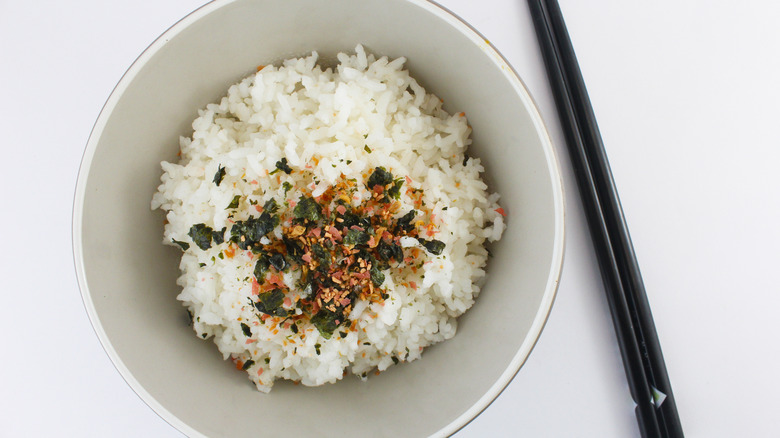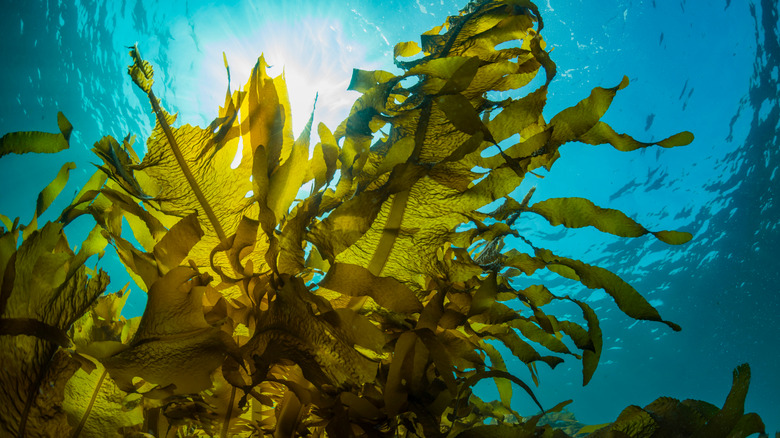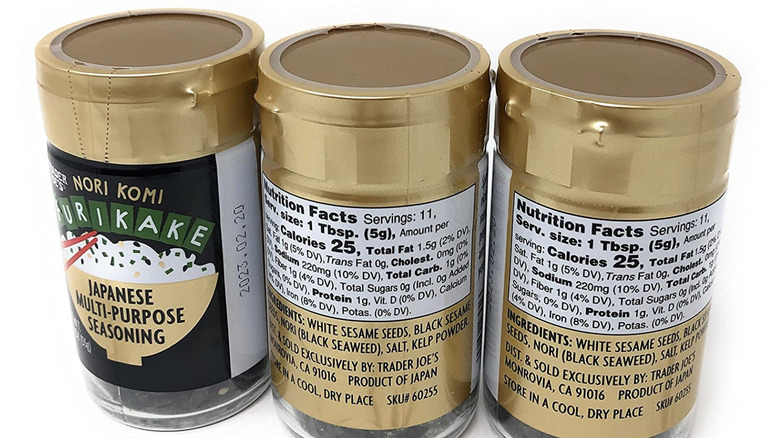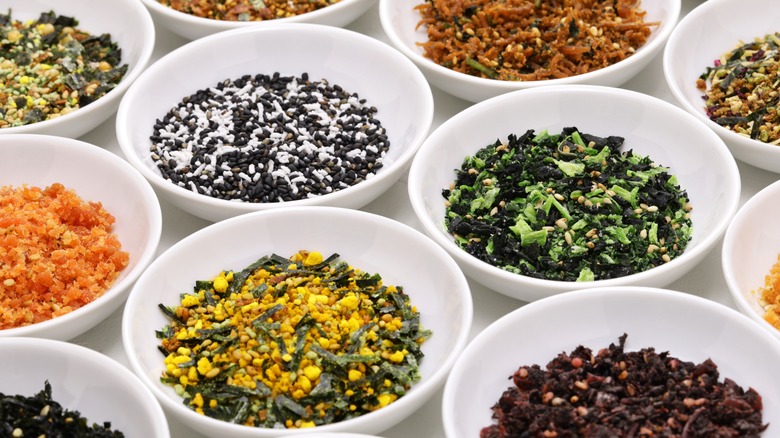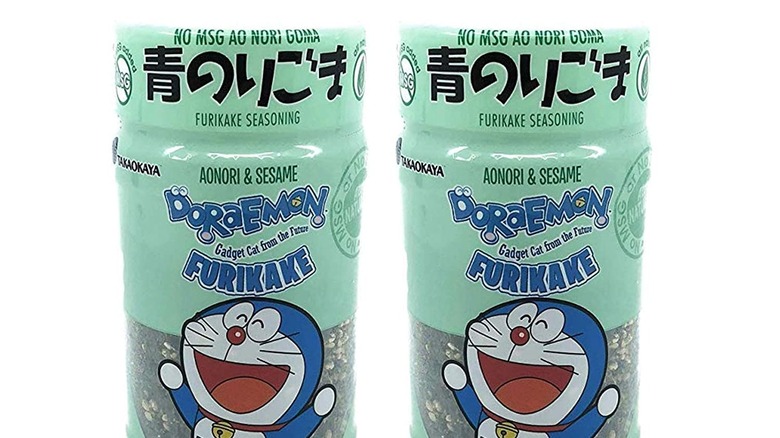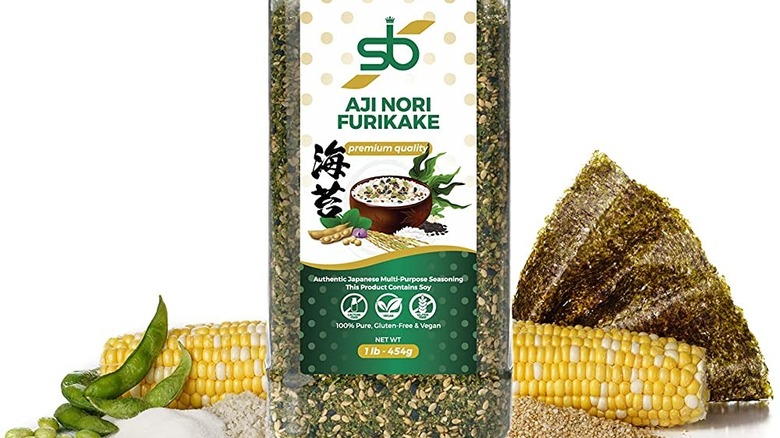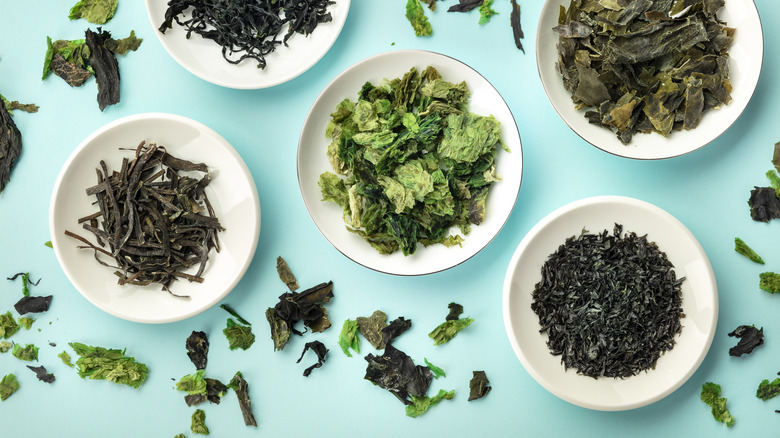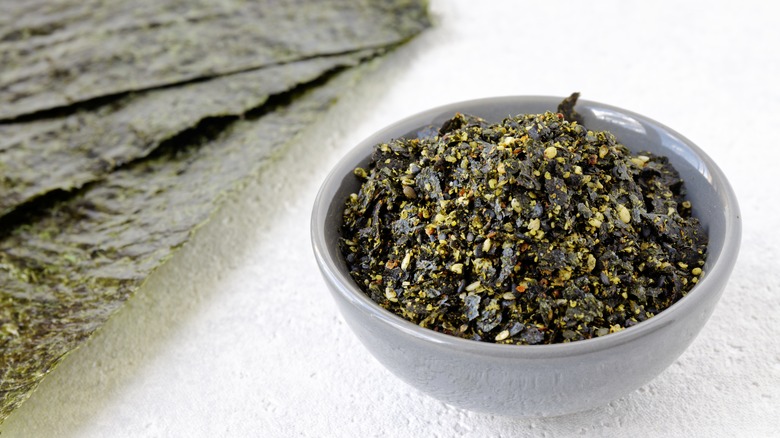Everything You Need To Know About The Japanese Topping Furikake
The same old spice blends can get old, and we are not just talking about the expiration date. (Think: Italian seasoning –- it's great for many a dish, but using it daily can diminish its appeal). Sometimes you need something new to awaken your taste buds. Enter furikake: a blend of dried seaweed flakes, sesame seeds, and sometimes bonito (fish) flakes, salt, and sugar. You might also find it seasoned with soy sauce, mirin, wasabi, or other flavorings.
For a seasoning that looks like mere fish food, it actually has a rich and savory umami flavor (and may even benefit your health). It can do wonders for bland foods like white rice. It can also elevate your roasted salmon without much more than a moderate sprinkle before you bake it (no salt nor lemon juice necessary). But what's amazing is that it's not only a seasoning but also a great way to increase the calcium, among other nutrients, in your diet. So, if you haven't already seen this one in the spice section of your local grocery mart, this is a seasoning combo you should consider trying.
It has a long history
The concept of furikake began over 12 centuries ago with the Japanese processing salted dried fish into flakes that they used in a variety of dishes. Then, during the early 1920s, Japanese pharmacist Suekichi Yoshimaru sought to improve calcium intake in the Japanese diet by combining dried fish particles (namely, ground fish bones) with other ingredients to make the fishy component more palatable. Yoshimaru's supplement contained crushed sardines, poppy seeds, and seaweed. It was sold and marketed as a "friend of rice" (known as Gohan no Tomu in Japanese) since rice was a major component in people's diets.
Though it was intended as a calcium supplement, furikake became a popular topping for white rice — a tradition that has remained a part of the culture. What's more, furikake has become a must-try for chefs across the globe — an influence for home cooks as well. These days, you might use it to jazz up the flavor in a variety of foods beyond white rice, taking dishes such as soups, salads, and appetizers up a notch. It can also up your culinary game, enhancing the flavor of your everyday meals.
It is a good source of calcium and other essential nutrients
When you take a bite of furikake-seasoned food, be it a bowl of rice, a filet of baked salmon, or a hearty vegetable-based soup, you may find it enhances a well-rounded flavor; some would liken it to an umami-richness. But the flavor is only half of this seasoning's benefit. What gives it such great flavor can also provide nutritional benefit. After all, it was designed as a supplement to improve calcium levels.
The high calcium levels come from the seaweed and crushed fish bones. Chile peppers, which are present in some versions to give it a bit of heat, also provide calcium. Nori and dulce seaweeds, which add a saltiness, also contain iodine and heart-healthy B vitamins. Dulce seaweed is a particularly good source of potassium and magnesium -– both of which are great for blood pressure control. And the sesame seeds with their mild, sweet, and nutty flavor provide some protein. And, if you enjoy a variety of furikake that includes smoky, savory bonito (fish) flakes, you will get some protein. Yes, bonito flakes contain some calcium, but you won't get much (if any) from the amount in your furikake.
It's salty, but not necessarily high in sodium
Furikake tastes salty in part due to the seaweed and, in non-vegan versions, fish flakes. But it isn't necessarily high in sodium. It really depends on the brand. JFC Shiso Fumi Furikake Rice Seasoning, which has salt among its ingredients, contains a whopping 2,290 milligrams of sodium per tablespoon. In comparison, Trader Joe's Nori Komi Furikake Japanese Multi-purpose Seasoning has a modest 220 milligrams of sodium per tablespoon. And if that still seems high, you can get plenty of flavor and lessen the sodium by using just a teaspoon (taking it down to just over 70 milligrams -– or about 3% of the U.S. Food and Drug Administration's daily recommended value of 2,300 milligrams of sodium). So you've got to read the labels and watch how much you use.
And, if you are still concerned about the sodium content on Trader Joe's furikake (or you'd prefer a more generous portion), there are lower sodium and no-salt versions available. Some low-sodium versions include Eden Shake Furikake with just 120 milligrams of sodium per tablespoon (20 milligrams per ½ teaspoon) and AoNori Goma Furikake Rice Seasoning (which is gluten-free and salt-free) and has only 30 milligrams of sodium per tablespoon (15 milligrams per ½ tablespoon).
It can deliver umami appeal
Furikake delivers a savory, meaty, and flavor-rich appeal. In fact, in the early 20th century furikake was developed in part to induce that umami satisfaction. The term "umami" refers to a fifth taste –- thanks to the naturally occurring glutamate present in many of our foods such as sardines, bonito, and seaweed — which are also traditional ingredients in furikake. Furthermore, bonito contains inosinic acid, which brings out the depth of the umami flavor. And the slow cooking process of smoking and drying, which is involved in developing this ingredient, brings out the umami potential to its fullest.
In fact, slow cooking anything with naturally occurring glutamic acid — such as caramelizing an onion – will elicit a good extent of umaminess because the process breaks down the compounds to allow a release of aromatic flavors. Even if you don't choose a furikake made with bonito or any umami-producing fish flakes, the condiment is designed to include the taste of umami. When you add an umami-rich component to your foods (i.e., furikake seasoning), you'll a get a complex, balanced, and long-lasting flavor. And the mouth-watering appeal is always there.
Types of furikake
If you think all furikake tastes the same, think again. Yes, furikake in general is designed as a salty, crunchy, umami-packed seasoning; and many furikakes contain seaweed, bonito flakes, and spices. But, depending on the proportions of ingredients and the seasonings used, furikake flavor profiles can differ widely. There are toasty varieties, smoky options, and even some with the puckeriness of (dried) pickles.
According to Sonoko Sakai, a Japanese American cooking teacher writing for Bon Appétit, gomashio, shisho, and katsuobushi are three classic furikake blends. Gomashio includes toasted sesame seeds and sea salt. The shiso variety is comprised of pickled red shiso leaves that are dried and ground up. The katsuobushi version contains bonito flakes with kombu seaweed, simmered in a combination of soy sauces, sake, and mirin until dry.
Modern packaged furikakes include some of the same classic combos as well as modern twists that include dehydrated egg, wasabi, nori, sardines, roe (fish eggs), umeboshi (pickled plum), meat, yuzu (a Japanese citrus fruit), curry, and other spices. Sakai says these modern options tend to be drier and crisper than homemade varieties. They also have a longer shelf life.
It's a versatile ingredient that can do wonders for rice and other foods
With its umami-rich flavor, furikake is a perfect way to season up a bland bowl of rice. And thus, it lives up to its founder's campaign –- as a "friend of rice". So, use it on rice, but don't limit the possibilities.
Furikake can be sprinkled on avocado toast. It will complement that mild, creamy avocado with a mouthwatering explosion of flavor! If you are using it to flavor salmon, start by brushing a light olive oil onto your filet, then shake on some furikake seasoning before (or after) you bake it. You can use it to season your popcorn. Before tossing in the furikake, drizzle or spray a little oil to lightly coat the popped kernels to help the seasoning stick. Or, take your sushi roll up a notch by mixing furikake into your sticky rice before preparing your roll. You'll discover that furikake is great in a variety of dishes such as soups, salads, baked potatoes, and so much more. Why not try it to season your scrambled eggs?
Use your imagination! For example, seaweed pairs well with hummus, avocado, and tahini –- so consider a creating a Lebanese-inspired sushi roll (or grain bowl) seasoned with furikake. Whether you add it into your cooking or just before serving, furikake a versatile ingredient that can take your meals and snacks up a notch.
Gluten-free versions are available
If soy sauce is among the ingredients, your furikake won't be gluten-free. But not all furikake contains soy sauce or any other gluten-carrying ingredients. Some gluten-free brands include AoNori Goma Furikake Rice Seasoning (which is also vegan and has no added salt or MSG), Aji Nori Furikake (also labeled as vegan and soy-free), and Nori Komi Furikake, which is also low in sodium and high in fiber.
According to Chopstick Chronicles, one way to ensure you are truly consuming a gluten-free furikake is to just make it yourself. Say you are making a classic katsuobushi furikake (infused with soy sauce, mirin, and sake). You can swap out the soy sauce for tamari sauce or coconut aminos instead. The sweet mirin wine is made from rice, which is gluten-free. And, while sake (a fermented alcoholic beverage also made from rice) is traditionally gluten-free, you should read the label just in case (as with all ingredients you plan to use).
You can find it with and without MSG
The use of MSG (monosodium glutamate) is a controversial topic. That's because for years people attributed MSG consumption to headaches and other health issues, though there isn't enough scientific data to support this. But MSG is nothing more than the sodium salt of a common amino acid — glutamic acid. And glutamic acid is found in many of the everyday foods we consume, including tomatoes, onions, mushrooms, and seafood. It is also present in seaweed. Cooking releases the glutamic acid (glutamate) from certain foods to impart a long-lasting, flavor-rich, mouthfeel (i.e., umami).
MSG can be created through the fermentation of sugars. But rather than waiting to cook down certain foods, you can rely instead on MSG crystals — an easy-to-use, convenient, umami-rich seasoning. And this is not necessarily a bad thing. In fact, MSG has one third the amount of sodium that table salt has.
Some packaged varieties of furikake may contain MSG, but the seasoning is also available without MSG. AoNori Goma Furikake Rice Seasoning, for example, does not have any added MSG.
Vegan options are available
Furikake may have originated with dried fish particles, but these days vegan options are available. Whether you choose to make your furikake at home so it's vegan or use a store-bought vegan furikake seasoning, you will find that the options are aplenty.
Muso from Japan's Sprinkling Yuzu Furikake is a vegan blend of toasted sesame seeds (both white and salt-cured black seeds), dried yuzu citrus zest, nori flakes, and sea salt. It gets plenty of mouth-watering flavor from the processes of curing and toasting as well as from the ingredients themselves –- the mild, nutty, and sweet sesame, the sweet-and-salty nori seaweed, and the fragrant and sour notes of the yuzu citrus (a food of Asian origin). You might also try SB Spices' Aji Nori Furikake Seasoning made with sesame seeds, sugar, sea salt, nori, hydrolyzed corn, and soy protein. Mishima's Nori Komi Furikake is vegan as well. It's got roasted white and black sesame seeds, salt, sugar, dried black seaweed, and powdered sesame seed. According to Mishima, its furikake has no artificial flavors or preservatives.
It's readily available and affordable
While furikake may not be the first thing you think about when visiting your local supermarket, it's becoming more widely available. In fact, Trader Joe's supermarkets carry the seasoning. And since Trader Joe's is currently in 42 states (plus Washington, D.C.), has 561 locations, and is available in 414 cities, that means furikake may be easier to find than you might have thought. Some varieties of furikake are also listed among the products sold at Harris Teeter, H-E-B, Safeway, Tom Thumb, Whole Foods, and Albertsons stores. Interestingly, it's available in regular supermarkets in Australia, too, according to Chopstick Chronicles.
You can also find furikake in some Asian markets such as Daiso, which has its flagship store in Soho, New York (and other New York locations), and is also found in California, Nevada, Texas, and Washington, as well as at 99 Ranch Market, which has locations in 10 states.And for convenience, you can find various brands of furikake online, including on Amazon.
It may help with GERD
If you've ever had gastroesophageal reflux disease, also known as GERD, you may be familiar with the discomfort and burn that comes with it. But there are certainly some foods that are soothing and may even help with healing. According to a 2019 review in the Turkish Journal of Gastroenterology, symptoms of chronic acid reflux have been treated for years with alginates, which are naturally present in seaweed. Alginates work in two ways to relieve GERD: They neutralize stomach acid, and they protect the sensitive areas of the esophagus and respiratory regions, including the throat and nasal passages, from acid reflux by forming a light gel barrier that coats the stomach.
Furikake contains seaweed. But you'll have to be careful on which product you choose because many varieties contain seasonings and additives that may be contraindicated for GERD, such as added sugars and chile spice. If you are seeking to soothe the burn and other symptoms related to acid reflux, look for a furikake product that is fresh, sustainably sourced, and free of additives. And always, you should read the labels to decipher whether the product contains any common GERD triggers such as spicy hot seasonings, citrus, tomatoes, vinegars, or added sugars.
Like any seasoning, it can expire
Will furikake go bad? The answer is yes, over time -– even though the ingredients are dry. Like any seasoning or food product, furikake can go beyond its shelf life, according to Chef Gourmet. This means it can lose its potency. So be sure to check the expiration date and refrigerate your furikake after opening. Once refrigerated, it may last for up to a month. And because the shelf life varies from product to product, be sure to read the label for its expiration date. Sure, an unopened bottle may last for months in your pantry. But, why let it collect dust when you can add such great flavor to your food?
If you are considering making your own furikake, it is best to consume within two to three days. And if you would like your homemade furikake to last longer, you may freeze it for up to three weeks. Be sure to label it and put it in a visible place in your fridge or freezer so it doesn't get lost among all the foods you pack in there.
You can make it yourself
While furikake is not hard to find these days, especially if you look online, you certainly can make it yourself. According to MasterClass, you'll need sheets of dried seaweed, such as nori, a container of dried fish flakes (if you choose to include bonito or any other type), and sesame seeds to get started (a combo of black and white is common in many furikakes). You may want to add shiso leaf, dried yuzu zest, shitake mushroom powder, miso powder, and seaweed that has been soaked in soy sauce then re-dried (i.e., katsuobushi). And you could consider adding a little MSG seasoning such as Accent or Aji No Moto Ajinomoto Monosodium Glutamate Umami Seasoning.
You'll have to chop the seaweed into fine bits and process into powder any ingredient that comes in a whole form. You may hand chop them, use a food processor, or even grind in a spice grinder. Then combine all your ingredients, seal in an air-tight container, and enjoy as you like.
